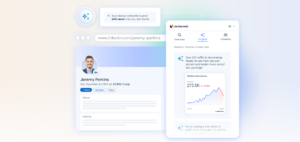Thomas Peham, VP of marketing at enterprise CMS Storyblok, explains how marketers can ensure their website is firing on all cylinders for the remainder of the festive rush…
Black Friday is widely considered the most important day on the retail calendar. Each year, it is used to provide an important measure of the economy, helping retailers to gauge spending levels, key trends and how well they will perform over the holiday season. Get it right and it can have a huge impact on overall profitability. But while potentially hugely lucrative, Black Friday and the ensuing holiday season can also prove incredibly challenging for brands and their martech teams tasked with pulling out all the stops to provide a standout online experience and seamless customer journey.
Research shows that a technological driven online experience will be key to securing sales and retaining brand loyalty this festive build-up with 40 percent of UK shoppers stating they are more likely to spend more money with brands that actively embed technology into the shopping experience. A further 20 percent admit they are more inclined to be loyal to those brands.
Yet the reality is that some marketers may struggle to meet the brief due to becoming increasingly overwhelmed by the volume of assets and communications channels they need to manage. Indicative of this, our own recent research reveals that over half (55%) of senior marketers are tasked with managing more than 1,000 assets and five channels. The study of 500 senior marketers also found that 48% say that the increasing complexity of marketing is leading to content mistakes such as broken links and outdated assets. A further 37% of marketers say they spend between 5-10 hours each month simply managing their assets, with 27% saying they have lost more than 10 hours to this routine task.
What’s the real shame is that delivering exceptional content experiences across complex omnichannel buyer journeys doesn’t necessarily have to be either complex or expensive.
The big mistake many companies make is in thinking that getting a big tech stack from a well-known brand is the best and easiest way to enable a successful, dynamic marketing output. Not only is this usually an expensive approach, but it may also mean being locked into using products that don’t fit your business’s changing needs. Cue the current content chaos as marketers are left struggling to keep with the sheer volume of assets and communications channels they need to manage.
Instead, there are now a huge range of new solutions available that, via APIs, can usually be easily integrated together. This means you have the freedom to build a suite of tools that work for your business. In addition, you also have the flexibility to swap out different solutions as your marketing develops. In this way, by investing in a more flexible CMS solution marketers are able to get new content out to multiple markets, platforms and channels, in line with evolving overall strategy, easily, at pace and at scale. The result is a truly flexible marketing approach and the ability to create meaningful, standout experiences which genuinely compete with bricks and mortar.
Of course though, that is not to create unnecessary panic. With Black Friday just around the corner, the reality is that there is probably not enough time for busy marketers and the brands they serve to make big sweeping changes to their current tech stack. Rather, my advice then is simply to take the time to cast a sharper focus on your online approach. The fact is that even making small incremental enhancements can have an outsized impact on conversions.
Foremost, I would recommend taking the time to consider how your current setup enables you to communicate with, and understand, your customers. Ideally, your business should have a system that allows you to quickly respond to customers on every relevant marketing channel with the right content at the right time. It should integrate into your sales and website analytics so you can easily track the effectiveness of each campaign, and decide which products need a harder push. If you find that your business is incapable of achieving this, then look at what you might be able to achieve in the short term.
It’s also important to take a look at how you are utilising your expertise to maximise the impact of your marketing. As we all know too well, gone are the days when a catchy email subject line or funny tweet would be enough to draw significant attention to your brand. You are no longer competing against your competitors but your customers’ last best online experience – so you need to make it count. Everything from delivering dynamic content on your website through to post-conversion follow up needs to happen. This requires having a marketing department that is multidisciplinary and cross-functional. They need to have data, development, commercial and marketing skills and, critically, ensuring a regular flow of information between other departments is essential. For example, data gleaned from marketing can inform product development and data gathered from areas such as customer service are needed to enable a truly personal experience. Here, it’s all about working smarter not harder to deliver, especially during the festive build up when content demands are higher.
The most important fix to make in all this is getting to grips with your data – without a good understanding of which channels your customers use the most and their prior purchasing behaviour your marketing and sales initiatives will be nothing more than guess work. Cleaning up your data and running rudimentary analysis is not as daunting as it seems. For those on a very tight budget there are plenty of guides online or the option of employing freelance data analysts. Although, I should point out that this is a very short term fix. From your analysis you can then decide which channel to focus your Christmas marketing efforts on.
Finally, when it comes to the bigger, long term picture, it may be worth considering whether there is a genuine business case for investing in a new tech stack. There’s a reason why more and more brands are pivoting from clunk legacy monolithic to MACH (Microservices, API-first, Cloud-based, and Headless) architecture. For the uninitiated, instead of being tied to a single platform, it means giving businesses the freedom to create tech stacks, applications and services that are specifically designed to their needs. A typical set up will combine different individual technologies to create one unified cloud-based setup that can communicate via APIs. The result? Better oversight, flexibility and adaptability, and the ability to handpick each individual technology to support your omnichannel needs, quickly and easily and with totally scalability. Perhaps then, for those who aren’t already doing so, one to add to 2024’s wish list?









